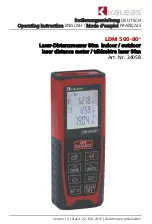
Extended Display Mode
You can use Extended Display mode to display data screens from your Descent device on a compatible Edge
device during a ride or triathlon. See your Edge owner's manual for more information.
Using an Optional Bike Speed or Cadence Sensor
You can use a compatible bike speed or cadence sensor to send data to your device.
• Pair the sensor with your device (
Pairing Your Wireless Sensors, page 83
).
• Set your wheel size (
Wheel Size and Circumference, page 100
).
• Go for a ride (
).
Training with Power Meters
• Go to
for a list of ANT+ sensors that are compatible with your device (such as
Vector
™
).
• For more information, see the owner's manual for your power meter.
• Adjust your power zones to match your goals and abilities (
Setting Your Power Zones, page 52
).
• Use range alerts to be notified when you reach a specified power zone (
).
• Customize the power data fields (
Customizing the Data Screens, page 69
).
Using Electronic Shifters
Before you can use compatible electronic shifters, such as Shimano
®
Di2
™
shifters, you must pair them with
your device (
Pairing Your Wireless Sensors, page 83
). You can customize the optional data fields (
). The Descent Mk1 device displays current adjustment values when the sensor is in
adjustment mode.
Situational Awareness
Your Descent device can be used with the Varia Vision
™
device, Varia
™
smart bike lights, and rearview radar to
improve situational awareness. See the owner's manual for your Varia device for more information.
NOTE: You may need to update the Descent software before pairing Varia devices (
the Garmin Connect App, page 33
).
Foot Pod
Your device is compatible with the foot pod. You can use the foot pod to record pace and distance instead of
using GPS when you are training indoors or when your GPS signal is weak. The foot pod is on standby and
ready to send data (like the heart rate monitor).
After 30 minutes of inactivity, the foot pod powers off to conserve the battery. When the battery is low, a
message appears on your device. Approximately five hours of battery life remain.
Improving Foot Pod Calibration
Before you can calibrate your device, you must acquire GPS signals and pair your device with the foot pod
(
Pairing Your Wireless Sensors, page 83
).
The foot pod is self-calibrating, but you can improve the accuracy of the speed and distance data with a few
outdoor runs using GPS.
1 Stand outside for 5 minutes with a clear view of the sky.
2 Start a running activity.
3 Run on a track without stopping for 10 minutes.
4 Stop your activity, and save it.
Based on the recorded data, the foot pod calibration value changes, if necessary. You should not need to
calibrate the foot pod again unless your running style changes.
84
Wireless Sensors
















































